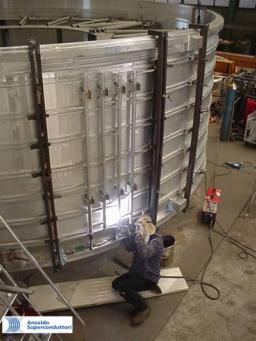Since 1996 Dapnia has been responsible for the general design of the solenoid for the CMS experiment of the Large Hadron Collider (LHC) project, as part of a collaboration agreement with CERN. Within Dapnia, SACM acts as the pilot division for the project in regard to the magnetic and thermal design of the magnet, supervision of assembly and surface testing at CERN. It is helped by the SIS (Service d’ingénierie des systèmes) as regards the mechanical design and instrumentation aspects, as well as industrial production monitoring. Apart from its size, what is particular to this solenoid are the conductor reinforced by an aluminium alloy and the design of an internal winding in an external cylinder. The years 2001 to 2003 saw the project move from the final study phase to that of component construction and start of assembly. These years allowed SACM to test a certain number of critical components before using them in the magnet.

One of the five winding modules under construction at the Ansaldo Superconduttori Company (by courtesy of INFN Genoa).
Once the general design of the cold mass had been passed in a joint technical review of the project in December 1998, the usual study and construction activities were actioned:
• Detailed drawings finalised.
• Technical specifications drawn up and calls for tender put out via CERN.
• Contractors chosen (with CERN).
• Construction monitoring right up to acceptance.
In effect, SACM is responsible for the technical aspects and is piloting the following sub-assemblies either built by European manufacturers, or built in countries that are taking part in the project. These are sub-assemblies that figured very early on in detailed studies. They are:
• The suspension system, made up of thirty titanium tie rods built in Russia; acceptance was issued in September 2003.
• The proximity cryogenics; construction is ongoing and acceptance is planned for February 2004.
• The heat shields built in Italy; the internal shields were installed at CERN in September 2003, the external shields will be installed in the third quarter of 2004.
• The French-built current lead system; it was installed and tested at Saclay in the 3rd quarter of 2003.
• The pumping system awarded to a German company; acceptance is planned for mid 2004.
SACM took part in follow up of the winding. Winding is carried out in Italy by the Ansaldo Superconduttori Company, under the auspices of the INFN (Instituto Nazionale di Fisica Nucleare) of Genoa. At the end of 2003, the five modules making up the winding were 60% completed. SIS is responsible for the internal instrumentation of the magnet diagnostics system and is taking an active part in the magnet control and safety systems.
The SACM test stations are used to specify and qualify some of the cold mass elements. The following are worthy of mention in particular:
• Critical current measurement of wires taken out of the conductor at various stages of its manufacture.
• Characterization of the mechanical aspects of the impregnation resin with reference to the surface state of the conductor.
• Cold and room temperature characterization of two types of titanium alloy in the mechanical test laboratory for making the suspension tie rods.
• Refitting a test station for testing all the tie rods under mechanical conditions at 110% of their loading, and under real thermal conditions, once two prototype tie rods have been tested.
In addition some specific plant has been refitted or developed:
• A test station for testing electrical connections under magnetic field up to 10 kA; two prototype connections of about 1 m in length displayed a resistance of about 0.9 n? under 2 teslas and 0.6 n? under zero field.
• A test station for testing the current leads at their nominal rating (20 kA), with and without cooling.
• A certain number of mock-ups built at Saclay to facilitate final assembly, such as the tie rod introduction mock-up.

Testing at CERN of the platform for fitting the cold mass of the CMS solenoid, using the vacuum vessel as load. The platform will be used to assemble and then to swing the solenoid from a vertical to a horizontal position.
The solenoid assembly procedure was studied in 2001, and then controlled by an external testing agency. The five solenoid modules will be assembled vertically, to make up the final cold mass. A large platform designed at Dapnia and built in South Korea will be used to support them. The platform will be pivoting so as to swing the coil into its final horizontal position where it will then be held in a cantilever position. The outer vacuum vessel will then be translated horizontally so that the coil can be inserted into it. This platform was successfully tested during the summer of 2002, using the inner vacuum vessel with counterweights to simulate the cold mass.
